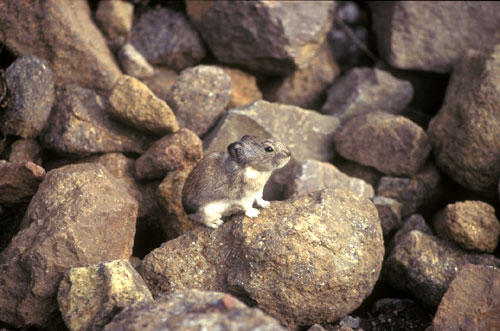 Alaska Science
Pikas love cold
Alaska Science
Pikas love cold
By NED ROZELL
March 18, 2010
Thursday
Pikas are cute, fist-size mammals with round ears that live in
lonely rock piles in Alaska's high country. Despite their hamster-like
appearance, they are more closely related to rabbits, and they
survive the winter beneath the snow, eating vegetation they stacked
in piles during summer.
Hayley Lanier studied collared pikas, which live on talus slopes
in Alaska and northwest Canada, for her doctorate at UAF. One
of her goals was to see if pikas might have adapted to the warmer
temperatures of recent decades.
 Pika
Pika
Photo by Link Olson
Pikas are intolerant of high
summer heat, and a species of pika in the lower 48 states has
disappeared from spots down there, possibly because their high-country
habitat is becoming too warm. Lanier measured skulls of pikas
that people had collected for the UA Museum of the North during
the last 60 years.
She and her advisor Link Olson noticed that a man named Robert
Spooner had collected a good number of the pika specimens that
she had used in her study. After wondering for several years
about the person who had so carefully prepared the delicate skins,
Olson found Spooner's name in the Fairbanks phone book and invited
him to attend Lanier's thesis defense. He accepted.
A UAF graduate student in the early 1960s, Spooner used a .410-gauge
shotgun loaded with No. 9 shot to retrieve pikas from several
locations in Alaska before deciding "research wasn't my
bag" and becoming a teacher in Fairbanks.
Lanier compared the body size of pikas Spooner had collected
off the Denali Highway to pikas she found in the same area 45
years later. She found the more modern pikas had larger skulls
and a shorter body length.
"They got more spherical," she said.
On hot summer days, pikas hunker down beneath rocks where the
air is cool. Extended bouts of hotter days might prevent larger
pikas from gathering enough food to survive winter, Lanier said.
But since pikas don't hibernate, larger, warmer bodies would
seem to be an advantage during winter. This evolutionary tug-of-war
between large and small body sizes has probably kept pikas' body
size constant, but it may have shifted during the last 40 years
or so. Lanier thinks the apparent increase in pika body size
might be due to more midwinter thaws of snow.
"We tend to assume that warm-blooded animals will get smaller
to conserve energy as average temperature increases," Olson
said. "But, in this case, pikas may be having to adapt to
colder temperatures beneath a thinner snow cover."
This column is provided
as a public service by the Geophysical
Institute, University of Alaska Fairbanks, in cooperation
with the UAF research community.
Ned Rozell [nrozell@gi.alaska.edu]
is a science writer at the institute.
E-mail your news &
photos to editor@sitnews.us
Publish A Letter in SitNews Read Letters/Opinions
Contact the Editor
SitNews
©2010
Stories In The News
Ketchikan, Alaska
|

